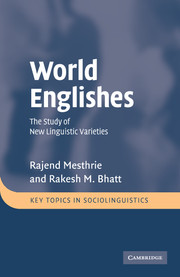Book contents
- Frontmatter
- Contents
- List of figures
- List of tables
- Preface
- Acknowledgements
- List of abbreviations
- 1 History: the spread of English
- 2 Structural features of New Englishes I: morphology and phrasal syntax
- 3 Structural features of New Englishes II: cross-clausal syntax and syntactic theory
- 4 More on structure: lexis and phonology
- 5 Pragmatics and discourse
- 6 Language contact and language acquisition issues in New English research
- 7 Conclusion: current trends in the spread of English
- Glossary
- Bibliography
- Author index
- Subject index
5 - Pragmatics and discourse
Published online by Cambridge University Press: 05 September 2012
- Frontmatter
- Contents
- List of figures
- List of tables
- Preface
- Acknowledgements
- List of abbreviations
- 1 History: the spread of English
- 2 Structural features of New Englishes I: morphology and phrasal syntax
- 3 Structural features of New Englishes II: cross-clausal syntax and syntactic theory
- 4 More on structure: lexis and phonology
- 5 Pragmatics and discourse
- 6 Language contact and language acquisition issues in New English research
- 7 Conclusion: current trends in the spread of English
- Glossary
- Bibliography
- Author index
- Subject index
Summary
INTRODUCTION
Thus far we have concentrated on the main structural differences between New Englishes and metropolitan varieties. But varieties of English also differ considerably from each other in terms of the functions to which linguistic structure may be put. An innovative structure in a particular New English may serve a new function or add a certain nuance not generally found in other varieties. Or what appears to be the same structure as in, say, Standard English, may serve a new function. In this chapter we first describe differences at the sentence level, before proceeding to speech acts and genres found widely in New Englishes. Such linguistic diversity generally reflects differences in social arrangements, cultural practices and historical processes to which language use is closely tied. Thus, in Singapore one notices a McDonald's billboard advertising their new sandwich made with rice buns: Have you eaten rice today? This play on the common Chinese greeting Have you eaten already? is lost on those English speakers who are not aware of the local cultural practices of Singapore. Similarly, in India, where English is one of two ‘official languages’, it is not uncommon to read a front-page headline such as Terror Tandava in Varanasi in a major English newspaper (Times of India, 8 March 2006). English speakers not familiar with historical-cultural literacies of India will find the use of Tandava opaque and will need local help for purposes of interpreting it appropriately in context (‘the dance of destruction performed by Lord Shiva’).
- Type
- Chapter
- Information
- World EnglishesThe Study of New Linguistic Varieties, pp. 131 - 155Publisher: Cambridge University PressPrint publication year: 2008



